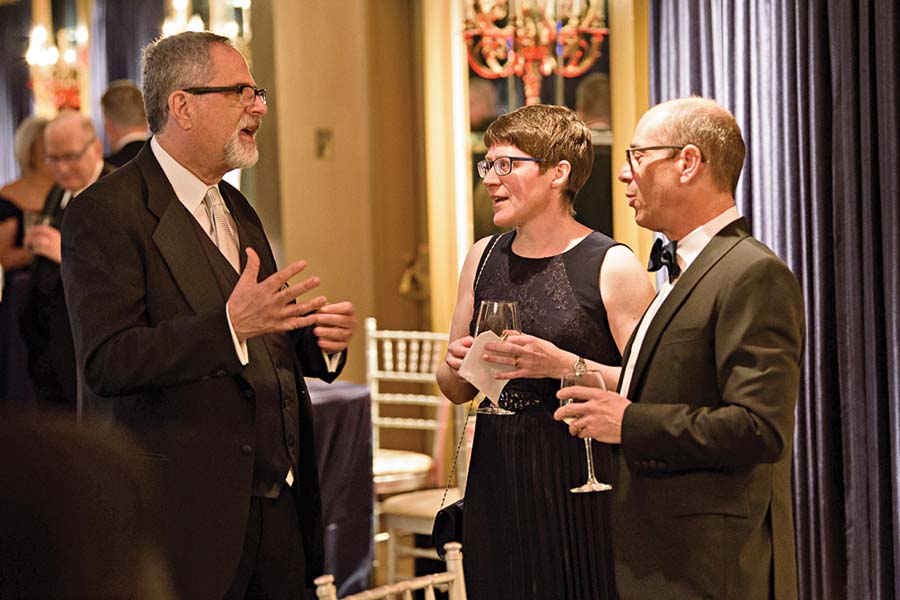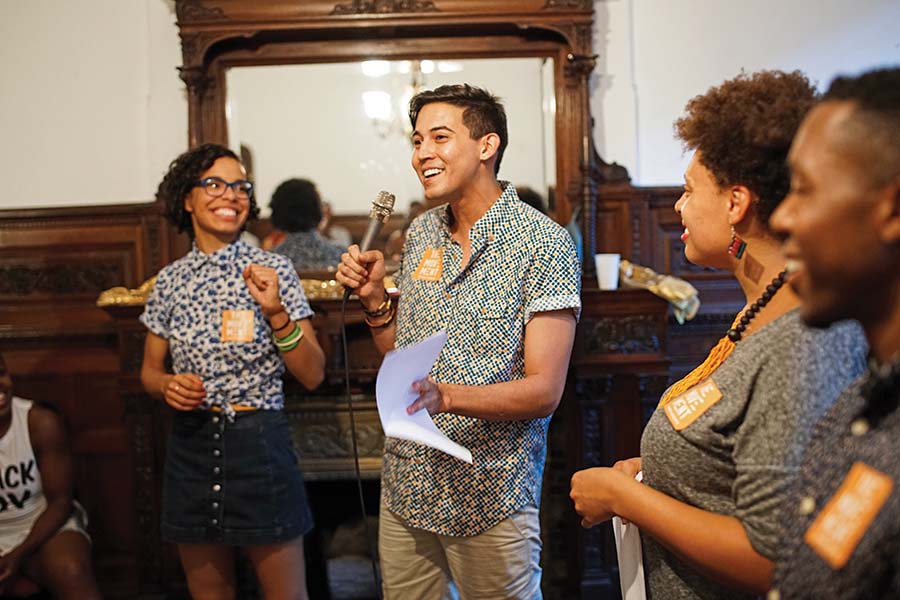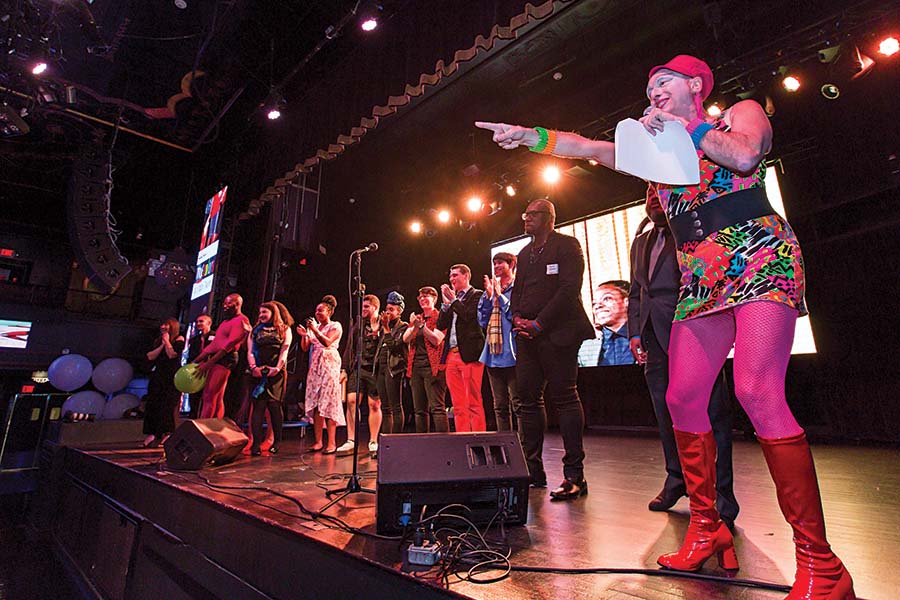In recent years, the fiscal realities of keeping a nonprofit theatre company operating “in the black” have required artistic directors to play a more active role in fundraising. Inevitably, this reduces the amount of time A.D.s have for such fundamental artistic duties as fulfilling the organization’s mission, planning the season, and so on. This has been exacerbated in part by the growing reliance on contributions from individual donors, as corporate, foundation, and government funding has been dwindling.
Stephen J. Albert, a veteran consulting and search-firm executive with Albert Hall & Associates (who died in late December, after we spoke), remembered a time when “an organization could operate on just a few large national grants.” But changes in the funding environment mean that organizations have had to focus on individuals, who by nature are responsive to in-person cultivation, requiring prolonged relationship-building in preparation for requests for support. Institutional donors may also respond to the personal touch, but most rely more heavily on written proposals and financial statements prepared by development and business office staff. With individual donors, the development officer is not the person they want to meet—it’s the artistic director.
“The artistic director is often ‘the face of the theatre,’ and because of that, she is the person most people want to meet,” said Emily Mann, artistic leader of Princeton, N.J.’s McCarter Theatre Center for the past 26 years. “I think the artistic director’s time should be used judiciously. But it is part of the artistic director’s job to represent the theatre, not only with major donors but with all members of the community. The idea is to grow single-ticket buyers into donors and subscribers, igniting interest and excitement in being a member at her particular institution.”
Albert agreed, saying, “Artistic directors are our stars. What has changed is that they also need to be civic leaders. This is a new profile for the next generation. We have moved away from the period where it was enough to do great work which would ensure funding. The artistic director is the personality who personifies the mission and makes it feel vibrant to the community.”
Michael Ritchie, artistic director of Center Theatre Group in Los Angeles for the past 12 years (following his leadership tenure at Massachusetts’s Williamstown Theatre Festival), puts the situation more urgently.
“Everyone in our building is ostensibly a fundraiser,” he said. “That’s the new reality for nonprofit theatres. We are all more dependent than ever on the success of our fundraising efforts. Fundraising is no longer optional for an artistic director; it’s an imperative.”
In an August 2017 American Theatre online article reporting on artistic leadership succession, Disney Theatrical Group president Thomas Schumacher suggested a reason for the new urgency: the global economic crisis of a decade ago. “Any artistic director who gets hired today will also be expected to go out and raise an awful lot of money,” said Schumacher, who spent five years on staff at the Mark Taper Forum. “That’s just different.”
Current job descriptions are candid about this decidedly unartistic job responsibility. For example, last fall’s posting for the soon-to-be-vacant job of artistic director at Washington, D.C.’s Woolly Mammoth Theatre Company clearly stated, “The artistic director will have an important role in cultivation and solicitation of major donors and foundations.” The same posting, prepared by Management Consultants for the Arts, noted that candidates should have “a clear comfort level, if not actual experience, in interacting with donors and potential donors, especially individuals and foundations; the ability to express artistic intention in written grant proposals and elsewhere is desirable.”

I’ve worked in development for a number of nonprofit arts organizations, and over the years some have asked how I came to be a good fundraiser. I always say I’ve had a lot of experience from a very early age: As a child, whenever I asked my mother to buy me something, she would reply curtly, “Go ask your father.” And so I did. Asking for what I wanted or needed was part of my upbringing.
Not so for Jennifer Zeyl, the new artistic director at Seattle’s Intiman Theatre, who has learned to be an effective fundraiser nonetheless. “I’m allergic to asking people for money,” Zeyl admits. “I’ve never asked my parents for money. I left home at a young age and worked multiple jobs through college and grad school. I was able to pay my student loans because my working sustained me financially. When Intiman shut down in 2011 due to financial difficulties, I was in the middle of designing a production there. I learned that the work of a nonprofit theatre does not come close to sustaining it.”
David Mendizábal, one of four producing artistic leaders of the Movement Theatre Company in Harlem, also acknowledges the impact of his upbringing on his feelings about asking for money. “Growing up in a Latinx household, there was a great deal of sensitivity around talking about money,” he said. He credits the mentorship of others for helping him learn the finer points of fundraising. “Cynthia Flowers, executive director of Soho Rep, taught us to be quiet after making the ask. My nervous instinct is to just keep talking, but I had to learn how to be comfortable in that moment of silence and simply wait for a response rather than undoing all the hard work I had just done.”
As a union scenic designer, Zeyl spent most of her time at Intiman offstage until recently. Her first fundraising meeting with a board member was scheduled to take place the week after we spoke. Intiman’s new executive director, Phillip Chavira, had done the work of setting up the meeting and briefing Zeyl. She expects that once she becomes acclimated to her new role, she’ll spend up to 25 percent of her time on fundraising—and more when Intiman hires a full-time director of development, who will presumably set up “three-hour lunches” requiring her participation.
Susan Booth, artistic director of the much larger Alliance Theatre in Atlanta, estimated that she too spends roughly a quarter of her time either in direct fundraising work or in structural work intended to better leverage the organization for support, although she said that mix “varies wildly over the course of the season.”
“It’s still a total calorie-burner to look someone in the eye and ask them for a gift of scale,” Booth confessed. “We just completed an enormous capital and endowment campaign, and I was in rooms with people who ended up making seven-figure gifts. But if you truly, madly, deeply love the work your theatre is doing, and believe mightily that that work is essential to the health and well-being of your city—then you make that case. And that isn’t hard. That’s actually fun.”
Chay Yew, artistic director at Chicago’s Victory Gardens Theater for more than six years, agrees. “I’m very comfortable when I’m articulating the mission and vision of the theatre, and the work we produce and the artists we support. In fact, sometimes I find it surprisingly helpful to articulate what we do as a theatre. It invigorates me to share our accomplishments, strategies, and dreams. It also helps me see what we need to do more of.”
Ekundayo Bandele, the founder and CEO of Hattiloo Theatre in Memphis, Tenn., which is roughly half the size of Victory Gardens and 34 years newer, estimates his development workload ratio is a bit higher than that of his colleagues. “Up to 80 percent of my time is spent fundraising, even before we hired our new full-time artistic director,” said Bandele (playwright Katori Hall took the job). “This is because the bulk of our income comes from donations. Ticket sales cover only 30 percent of our budget.”
When asked if he had any fundraising experience before founding Hattiloo, Bandele responded, “Not a lick. It was all on-the-job training.” He is grateful to multiple mentors for showing him the ropes. Candid feedback from donors also helps. “A few years ago, we made a calendar with beautiful production stills to send to our most faithful supporters. One donor sent it back to me with a note that read, ‘Don’t spend my money on this.’”
Abe Rybeck, the founder and executive artistic director of another smallish but profoundly impactful company, The Theater Offensive in Boston, said, “Sometimes it feels like I spend 120 percent of my time doing fundraising, and it also feels like that’s way less than I’m supposed to be doing.”
Movement Theatre Company’s Mendizábal says that over the 10 years he has served in the A.D. role, he’s had to accept that raising money is “a huge part of the job and you have to do it. You can’t say, ‘I’m so scared!’ Either get over it, or get out of the way.” The challenge, he said, was to dismantle his fear, and he was able to do it by thinking about the fact that it’s not about the money—it’s about the project and doing what it takes to make that project happen.
Mendizábal has learned what Albert has known all along: that enthusiasm and excitement, when communicated well, are contagious. Mendizábal is a charismatic communicator and good at getting to the moment of the ask. As he sees it, what’s the worst that could happen? That the donor says “no.”
CTG’s Ritchie also shared this advice for fundraising novices: “The biggest thing to remember is that you’re asking for money to support a cause, not for yourself. Once I realized that basic idea, it was much easier to begin the conversation. What’s important for up-and-coming artistic directors to know is that your relationships with board members need to be personal. That personal dynamic is extremely important. It should never feel transactional. It’s all about relationships, because we all care about the sustainability of the art.
“Both the relationship and an ask must always be authentic,” Ritchie continued. “That authenticity allows me to never feel embarrassed to ask for money, because we identify people who have a passion for the same thing. It’s not always the best strategy to ask for money right out of the gate. I always tell a potential donor that if their answer is no, nothing in our relationship will change.”

Rybeck, another artistic leader with a lot of fundraising experience, isn’t afraid to make the ask, either. But he admits that he does find the process not only time-consuming but also emotionally taxing.
“It’s painful to ask a major donor prospect for a lot of money,” Rybeck said. “If they say no, I’m crushed, in tears, and asking myself, ‘What have I done wrong?’ But if they say, ‘Yes, I am proud to support you and your important work,’ I find myself in tears anyway, profoundly touched by the dedication of the donor, and daunted by the fact that I have so much to live up to.”
In describing her fundraising role, the Alliance’s Booth used business language that may appeal to a certain type of donor: “I have to develop and articulate a value proposition for the theatre in the community and in the field that makes it an unassailably smart investment option for a donor.”
As a female executive, Zeyl says that the most important element in being an artistic director is to be a “whole human” and not select compartmentalized parts of yourself. “My path has relied heavily on individualism,” she said. “I’m confident in my strengths and surround myself with talented people who have strengths that complement mine. Be human, encourage authenticity, and take care of yourself,” she advised.
The bottom line is that, while the financial picture may have changed, the fundamental roles haven’t: Artistic directors are still the ones most qualified to speak passionately and engagingly about the theatre’s mission, their vision, and their work. Professional fundraisers can and should do the rest. “Mechanics and relationship management are handled by other people,” Albert agreed. Experienced development staff—if your theatre is large enough and lucky enough to have one—does the work of identifying donor prospects, researching them, developing cultivation strategies, making introductions, scheduling meetings, and, hopefully with the help of the board for peer-to-peer engagement, making the ask and working out all the details. Artistic directors’ fundraising efforts should consist only of attending meetings and events, and speaking about the theatre’s work in a way that will get the donor prospect excited and eager to get involved. Presumably they’ve already shown that skill in interviews to get the job.
As demonstrated in the examples above, on-the-job training can be very effective, especially if an A.D. doesn’t have a development staff to fall back on. So should search firms and boards require artistic director candidates to have extensive fundraising experience before they can even get their foot in the door? Given the way most current A.D.s have come to their jobs—from directing, stage managing, even designing—it hardly seems fair to today’s prospective candidates to raise the bar in this way, and it may have the effect of keeping out talented leaders of diverse backgrounds. After all, for certain asks, Albert noted, the artistic director “doesn’t need to be involved at all. A search committee is looking for someone they can invest in, follow, spend time with. The other stuff will follow.”
With as many as 20 current or upcoming A.D. vacancies at major U.S. theatre companies across the country, the question of qualifications and “new blood” is pressing. Zeyl is passionate on this point. “The way we are looking for artistic directors now is all wrong,” she said. “It is time for a major shift in the culture of arts leadership in this country.” This squares with recommendations that followed the release of a 2015 study by the Wellesley Centers for Women, which measured artistic leadership in 2013-14. The study found that 73 percent of U.S. artistic directors and 62 percent of executive directors at leading U.S. LORT theatres were white men.
All of the artistic directors interviewed for this article agree that, for all their involvement in fundraising, they do not feel the need to micromanage those efforts because they work with highly capable staff colleagues.
“I’m in constant conversations with our staff to track annual fundraising goals and progress,” Ritchie said. “I always have the big picture in my head and work with an expert team of fundraisers to ensure we’re always making progress.”

Of course, the ideal donor is one who contributes because they believe in the mission of the organization and want to support it. But there are always the rogue individual donors who throw their weight around and want to know what’s in it for them if they make a big gift. These donors, A.D.s generally agree, are to be avoided at all costs.
Rybeck tells an amusing story of a corporate donor, a bank, that was cultivated to underwrite a “sexy, dirty fundraising event called climACTS!” As Rybeck recalled, “Knowing that corporate contribution money often comes out of advertising budgets, we were concerned about how much this bank would want their name and logo pasted everywhere. When we finally got this sponsorship, it came with one big stipulation: that the name of the bank not be present anywhere at the function. ‘Hmm,’ I thought, ‘I guess this is the last time we’ll ever get a sponsorship from them, since they’re getting nothing out of this.’”
As a general rule, A.D.s note, beware of strings attached. Theatres have been presented with such dilemmas as an offer from a donor to contribute literally millions of dollars to a theatre if, in return, the theatre would produce his nephew’s subpar play. Another artistic leader confessed that the relative of a donor was hired by his theatre, but added that the relative is actually an outstanding artist with whom the company has a positive ongoing relationship.
Albert said he tried to look at the bright side of fundraising, rather than the “eat your vegetables” aspect.
“One of the best things about leadership jobs is that, through the board and the patrons, you get introduced to interesting groups of people—people you may never have interacted with otherwise—for the good of the community. It can be a difficult adjustment. You’re not peers, but friendships develop and you can build positive relationships that last a lifetime.”
Every artistic director needs to be able to passionately communicate the theatre’s mission and vision, be a good storyteller, and generate spark and excitement. “Don’t bullshit,” Victory Gardens’ Yew advises. “You know it’s bullshit, and so do the folks across the table who took time out of their schedule to meet with you. They are there because they are already interested in supporting your theatre. Invite them to your party.”
Whether it’s talking to the press, actors, directors, designers, the board—or, yes, even well-vetted donor prospects—the principle is the same: Fundraising is not for you, it’s for the people the organization serves. That helps make it an easy ask.
Lisa Lacroce Patterson is a freelance writer who has also worked as an arts administrator for 30 years.


